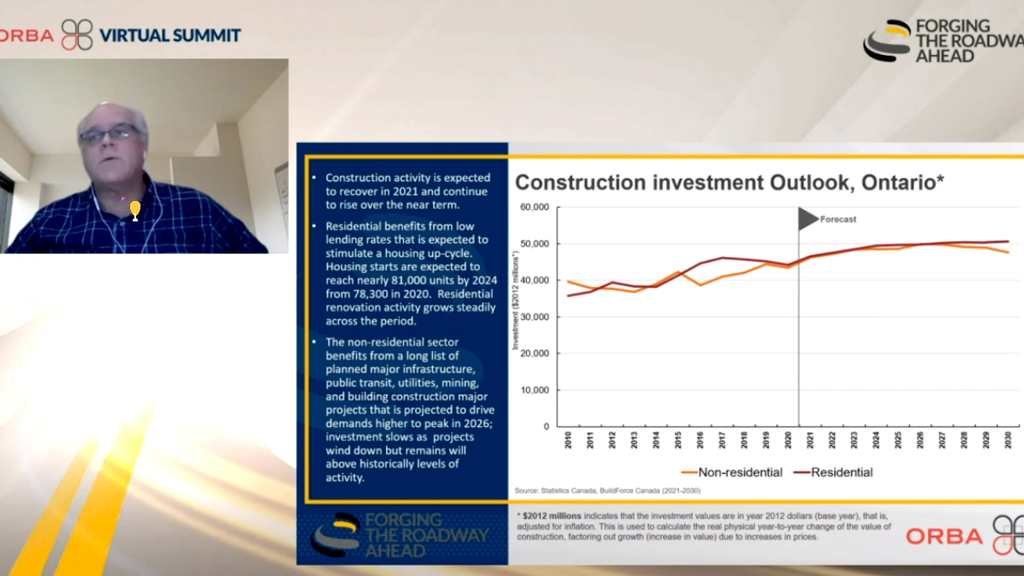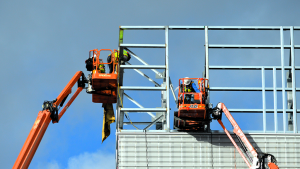As the country continues to make its way through the pandemic, uncertainty remains for the commercial construction sector in 2021, despite an overall recovery in activity in the near term, reports Bob Collins a senior economist with BuildForce Canada.
“There was a big dip in commercial where a lot of projects were put on hold or deferred or could be deferred indefinitely,” said Collins, who presented the Ontario 2021 Construction and Maintenance Labour Market Update, a preliminary outlook for the province at the Ontario Road Builders’ Association’s Virtual Summit recently.
“There is really a lot of uncertainty there.”
The final Labour Market Information forecasts for 2021 to 2030 are expected to be released in March. Collins’s presentation was based on consultation with industry stakeholders throughout the year, including meetings on the impact of COVID-19.
According to marketplace trends, demand for commercial construction was particularly hard hit by COVID-19 and it may take several years before investment returns to pre-pandemic levels.
Engineering construction offset the declines in ICI and should continue to do so until the middle of the decade.
“Non-residential construction is driven by a long list of projects and that really offset some significant declines in commercial construction,” said Collins. “Basically, when you have the energy of this many projects and they proceed as scheduled it’s very much going to be an uptick in overall construction activity for the non-residential construction industry in Ontario.”
Even before COVID, much of the investment in Ontario was being driven by engineering construction, explained Bill Ferreira, executive director of BuildForce Canada, in an email to the Daily Commercial News. The expansion of the public transit systems in Toronto and Ottawa, utility upgrades and mining activity in Ontario’s north drive up engineering demand and were not impacted by the pandemic as much as ICI construction.
ICI is being driven by health care projects. In 2021, institutional construction is expected to remain relatively strong and industrial construction is expected to rise as the economy reopens.
“In the outlook scenario, we are being a little conservative that private investors will be a little more cautious post-COVID in the province and the municipalities will have to wrestle with deficits and debt over the near term.”
Pandemic impacts construction employment
According to the outlook, construction employment increased as the economy reopened after the spring shutdown, recovering lost jobs but still remained below 2019 levels. The average annual unemployment rate increased from 5.3 per cent in 2019 to 7.9 per cent in 2020.
“Looking at last year, 2020, across all the provinces, the impact was gigantic,” said Collins. “If you look at 2019, you see solid levels of activity for Ontario. We see the unemployment rate going, during peak seasons, down to 3.5 per cent, which is extremely low. That means the markets had to be very tight across all the market segments.
“Then you see the unemployment rate skyrocket right up through March and April. In two months we lost over 90,000 workers. The unemployment rate went from 5.4 to about 14 per cent.”
While the unemployment rate started to come down, research shows employment was growing a little bit faster than the labour force.
“This means some people were sitting on the fence and not getting back to the jobsite. That’s why we see the unemployment rate decline through August and September, so employment was growing faster than the labour force,” Collins pointed out. “We saw some of the labour force return, but not all have returned.”
Mobility of workers could be an issue
In terms of mobility, on average there is not a lot of flexibility for movement of workers across the five regions in Ontario.
“We’re already hearing on some projects workers coming in from outside of the province to meet demands. That has some challenges with the COVID conditions and the rollout of the vaccine,” said Collins. “The mobility of the workforce has some issues as we move through 2021 and into 2022.”
There are still risks, he added, as the situation continues to evolve.
“As our forecast team looks at this, the data is constantly changing. We are squeezing numbers, we get updates and while we are not seeing a lot of change to the major projects that we looked at last year, there have been some schedule implications.
“For the most part we are seeing a lot of the projects that were scheduled to still be proposed or remain underway,” he said. “The challenge is getting that final investment decision in between shovel ready and in the ground and rolling. That can create some delays that could play out in 2021 but the level of projects and work are there.”
Follow the author on Twitter @DCN_Angela.











Recent Comments
comments for this post are closed